Federico Cinus
Online Minimization of Polarization and Disagreement via Low-Rank Matrix Bandits
Oct 01, 2025Abstract:We study the problem of minimizing polarization and disagreement in the Friedkin-Johnsen opinion dynamics model under incomplete information. Unlike prior work that assumes a static setting with full knowledge of users' innate opinions, we address the more realistic online setting where innate opinions are unknown and must be learned through sequential observations. This novel setting, which naturally mirrors periodic interventions on social media platforms, is formulated as a regret minimization problem, establishing a key connection between algorithmic interventions on social media platforms and theory of multi-armed bandits. In our formulation, a learner observes only a scalar feedback of the overall polarization and disagreement after an intervention. For this novel bandit problem, we propose a two-stage algorithm based on low-rank matrix bandits. The algorithm first performs subspace estimation to identify an underlying low-dimensional structure, and then employs a linear bandit algorithm within the compact dimensional representation derived from the estimated subspace. We prove that our algorithm achieves an $ \widetilde{O}(\sqrt{T}) $ cumulative regret over any time horizon $T$. Empirical results validate that our algorithm significantly outperforms a linear bandit baseline in terms of both cumulative regret and running time.
Engagement-Driven Content Generation with Large Language Models
Nov 21, 2024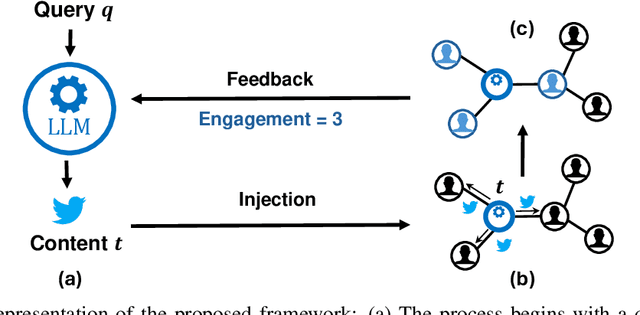
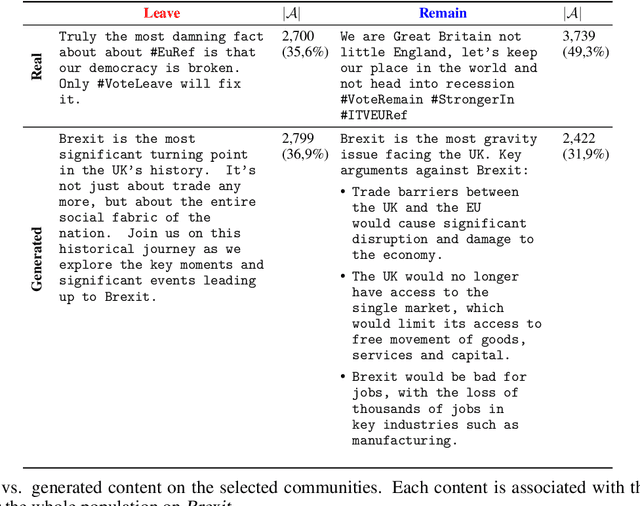
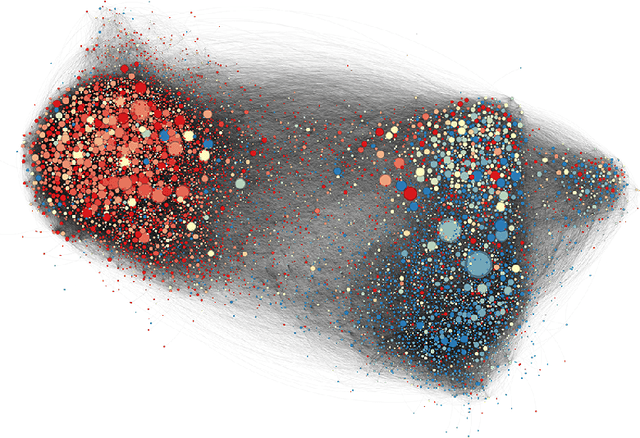

Abstract:Large Language Models (LLMs) exhibit significant persuasion capabilities in one-on-one interactions, but their influence within social networks remains underexplored. This study investigates the potential social impact of LLMs in these environments, where interconnected users and complex opinion dynamics pose unique challenges. In particular, we address the following research question: can LLMs learn to generate meaningful content that maximizes user engagement on social networks? To answer this question, we define a pipeline to guide the LLM-based content generation which employs reinforcement learning with simulated feedback. In our framework, the reward is based on an engagement model borrowed from the literature on opinion dynamics and information propagation. Moreover, we force the text generated by the LLM to be aligned with a given topic and to satisfy a minimum fluency requirement. Using our framework, we analyze the capabilities and limitations of LLMs in tackling the given task, specifically considering the relative positions of the LLM as an agent within the social network and the distribution of opinions in the network on the given topic. Our findings show the full potential of LLMs in creating social engagement. Notable properties of our approach are that the learning procedure is adaptive to the opinion distribution of the underlying network and agnostic to the specifics of the engagement model, which is embedded as a plug-and-play component. In this regard, our approach can be easily refined for more complex engagement tasks and interventions in computational social science. The code used for the experiments is publicly available at https://anonymous.4open.science/r/EDCG/.
Link Polarity Prediction from Sparse and Noisy Labels via Multiscale Social Balance
Jul 22, 2024Abstract:Signed Graph Neural Networks (SGNNs) have recently gained attention as an effective tool for several learning tasks on signed networks, i.e., graphs where edges have an associated polarity. One of these tasks is to predict the polarity of the links for which this information is missing, starting from the network structure and the other available polarities. However, when the available polarities are few and potentially noisy, such a task becomes challenging. In this work, we devise a semi-supervised learning framework that builds around the novel concept of \emph{multiscale social balance} to improve the prediction of link polarities in settings characterized by limited data quantity and quality. Our model-agnostic approach can seamlessly integrate with any SGNN architecture, dynamically reweighting the importance of each data sample while making strategic use of the structural information from unlabeled edges combined with social balance theory. Empirical validation demonstrates that our approach outperforms established baseline models, effectively addressing the limitations imposed by noisy and sparse data. This result underlines the benefits of incorporating multiscale social balance into SGNNs, opening new avenues for robust and accurate predictions in signed network analysis.
Rebalancing Social Feed to Minimize Polarization and Disagreement
Aug 28, 2023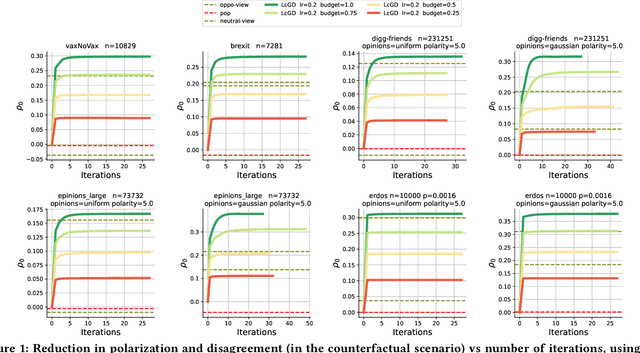
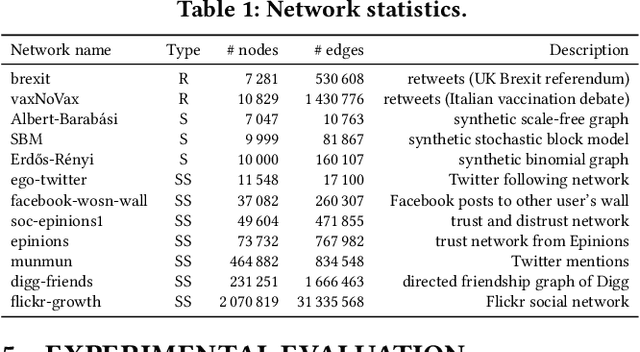
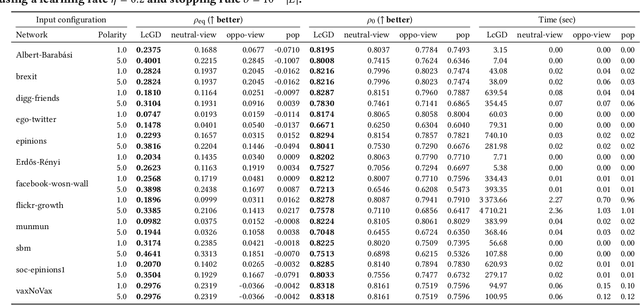

Abstract:Social media have great potential for enabling public discourse on important societal issues. However, adverse effects, such as polarization and echo chambers, greatly impact the benefits of social media and call for algorithms that mitigate these effects. In this paper, we propose a novel problem formulation aimed at slightly nudging users' social feeds in order to strike a balance between relevance and diversity, thus mitigating the emergence of polarization, without lowering the quality of the feed. Our approach is based on re-weighting the relative importance of the accounts that a user follows, so as to calibrate the frequency with which the content produced by various accounts is shown to the user. We analyze the convexity properties of the problem, demonstrating the non-matrix convexity of the objective function and the convexity of the feasible set. To efficiently address the problem, we develop a scalable algorithm based on projected gradient descent. We also prove that our problem statement is a proper generalization of the undirected-case problem so that our method can also be adopted for undirected social networks. As a baseline for comparison in the undirected case, we develop a semidefinite programming approach, which provides the optimal solution. Through extensive experiments on synthetic and real-world datasets, we validate the effectiveness of our approach, which outperforms non-trivial baselines, underscoring its ability to foster healthier and more cohesive online communities.
Cascade-based Echo Chamber Detection
Aug 09, 2022
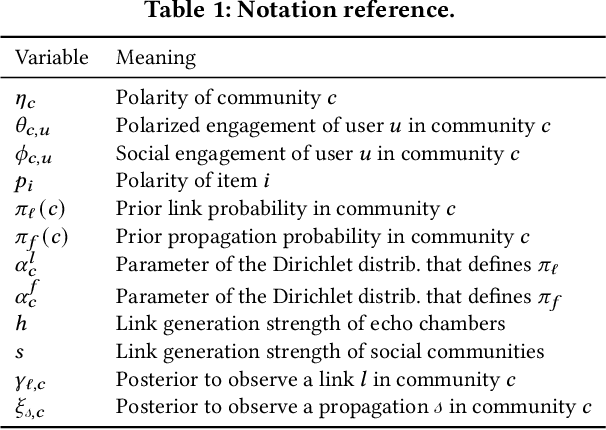
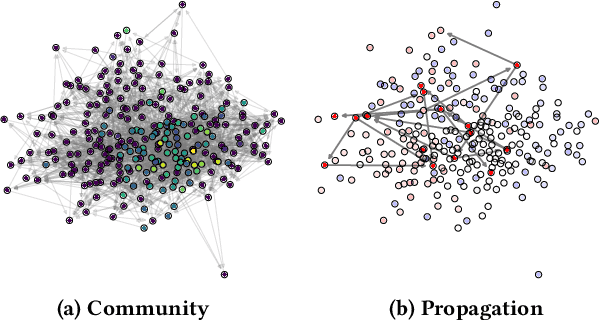

Abstract:Despite echo chambers in social media have been under considerable scrutiny, general models for their detection and analysis are missing. In this work, we aim to fill this gap by proposing a probabilistic generative model that explains social media footprints -- i.e., social network structure and propagations of information -- through a set of latent communities, characterized by a degree of echo-chamber behavior and by an opinion polarity. Specifically, echo chambers are modeled as communities that are permeable to pieces of information with similar ideological polarity, and impermeable to information of opposed leaning: this allows discriminating echo chambers from communities that lack a clear ideological alignment. To learn the model parameters we propose a scalable, stochastic adaptation of the Generalized Expectation Maximization algorithm, that optimizes the joint likelihood of observing social connections and information propagation. Experiments on synthetic data show that our algorithm is able to correctly reconstruct ground-truth latent communities with their degree of echo-chamber behavior and opinion polarity. Experiments on real-world data about polarized social and political debates, such as the Brexit referendum or the COVID-19 vaccine campaign, confirm the effectiveness of our proposal in detecting echo chambers. Finally, we show how our model can improve accuracy in auxiliary predictive tasks, such as stance detection and prediction of future propagations.
 Add to Chrome
Add to Chrome Add to Firefox
Add to Firefox Add to Edge
Add to Edge